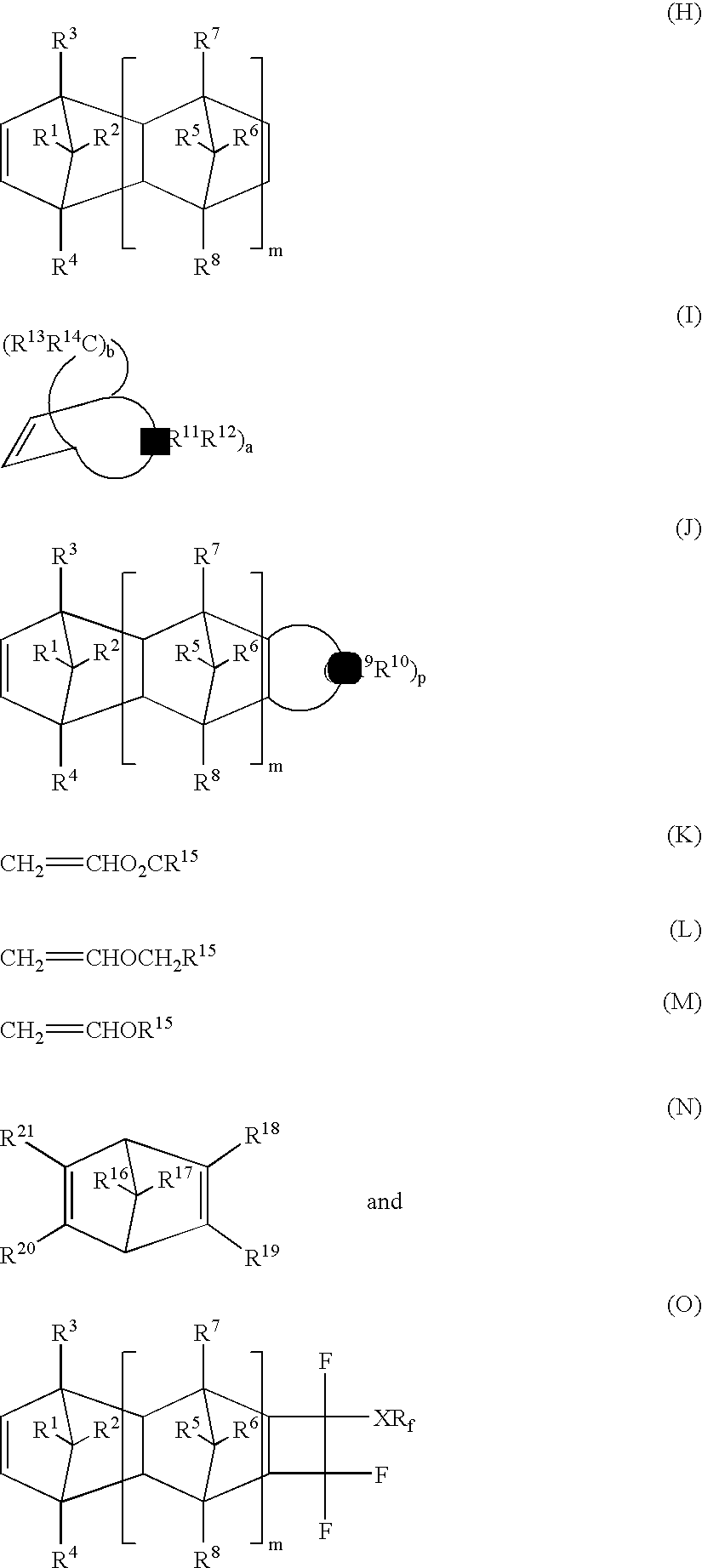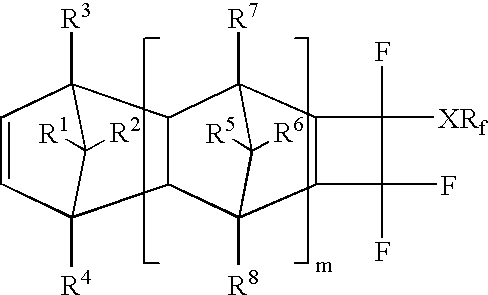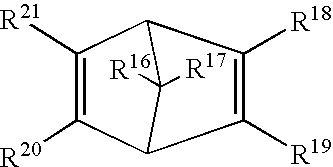Photoresists, polymers and processes for microlithography
a technology of microlithography and polymer, applied in the field of photoimaging, can solve the problems of not teaching that the compositions disclosed could be used in photoresists, and the use of copolymers is not disclosed. achieve the effects of high plasma etch resistance, good balance of desirable properties, and high transparency
- Summary
- Abstract
- Description
- Claims
- Application Information
AI Technical Summary
Benefits of technology
Problems solved by technology
Method used
Image
Examples
example 1
Synthesis of TFE / Norbornene Copolymer=P(TFE / NB)
A 1-L stirred Hastelloy autoclave was charged with a solution of 28.2 g (0.30 mol) norbornene in 300 mL CFC-113. The autoclave was closed, pressured to 200 psi with nitrogen three times, cooled and evacuated. TFE (35 g, 0.35 mol) was added and the mixture was heated with stirring to 40° C. A 25 mL portion of a solution of 5.0 g of 60% di(sec-butyl)peroxydicarbonate in 50 mL of CFC-113 was injected over 5 min. The resulting mixture was stirred for about 18 hr. The reactor was cooled, vented and the clear colorless solution was removed using CFC-113 to rinse. Polymer was isolated by precipitation of the CFC-113 solution into excess methanol. The white solid was filtered and dried in a vacuum oven overnight at about 45° C. Isolated yield was 7.4 g of white polymer; GPC (MEK) Mw 2800, Mn 1700, Mw / Mn 1.59; Inh. Visc. 0.0271 (MEK). Anal. Found: C, 54.27; H, 5.28; F, 30.81. From the % H, the composition of the polymer was calculated as 49 mol ...
example 2
Synthesis of TFE / Norbornene Copolymer=P(TFE / NB)
A 400 mL stainless steel pressure vessel was charged with a solution of 33 g (0.35 mol) norbornene in 120 mL of CFC-113. Perkadox® 16 N (1.20 g) was added. The vessel was closed, purged with nitrogen, cooled, evacuated and charged with 40 g (0.40 mol) TFE. The vessel was heated with shaking to 50° C. and maintained for 18 hr with the internal pressure decreasing from 200 psi to 167 psi. The vessel was cooled, vented and the liquid contents recovered using additional CFC-113 to rinse. Polymer was isolated by precipitation of the CFC-113 solution into excess methanol. The white solid was filtered and dried in a vacuum oven overnight at about 65° C. Isolated yield was 29.7 g (41%) of white polymer; GPC (MEK) Mw 10000, Mn 2900, Mw / Mn 3.57; Inh. Visc. 0.0130 (MEK). Anal. Found: C, 54.60; H, 5.05; F, 31.21. From the % C, the composition of the polymer was calculated as 52 mol % TFE and 48 mol % norbornene.
example 3
Synthesis of TFE / Norbornene Copolymer=P(TFE / NB)
The procedure of Example 2 was followed using 47 g (0.5 mol) norbornene, 120 mL CFC-113, 1.6 g Perkadox® 16N and 50 g (0.50 mol) TFE with polymerization conducted at 40° C. for 18 hr. There was isolated 19.7 g (20%) of white polymer; GPC (MEK) Mw 10600, Mn 3700; Mw / Mn 2.89; Inh. Visc. 0.0195 (MEK); Tg 152° C. (DSC). Anal. Found: C, 58.33; H, 5.63; F, 33.13. From the % C analysis, composition of the polymer was calculated as 46 mol % TFE and 54 mol % norbornene.
PUM
| Property | Measurement | Unit |
|---|---|---|
| Nanoscale particle size | aaaaa | aaaaa |
| Wavelength | aaaaa | aaaaa |
| Wavelength | aaaaa | aaaaa |
Abstract
Description
Claims
Application Information
 Login to View More
Login to View More - R&D
- Intellectual Property
- Life Sciences
- Materials
- Tech Scout
- Unparalleled Data Quality
- Higher Quality Content
- 60% Fewer Hallucinations
Browse by: Latest US Patents, China's latest patents, Technical Efficacy Thesaurus, Application Domain, Technology Topic, Popular Technical Reports.
© 2025 PatSnap. All rights reserved.Legal|Privacy policy|Modern Slavery Act Transparency Statement|Sitemap|About US| Contact US: help@patsnap.com



